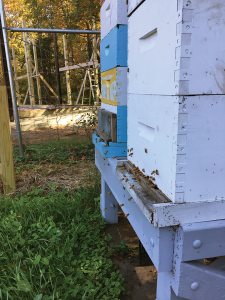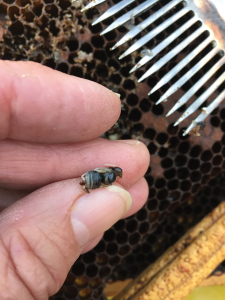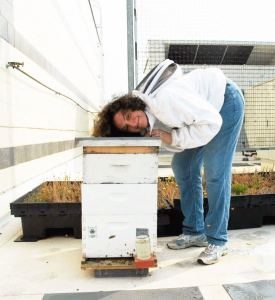Please, Be A Good Neighbor
In this season of vitriol we should all perhaps stand down, but there is something that must be said: if you are not raising or using locally-bred queens, or introducing hygienic lines, and you think you are doing survivor stock, you are an idiot. And I am so mad at you that my hands are shaking. My urban treatment-free neighbors, you have just cost me a colony, and a really precious one, too. In fact, I contend that your (lack of) effort is actually an obstacle, and potentially an insurmountable one, to the development of sustainable, resistant bees. Which does not even mention the hammer you are putting down on native bees in your area (Fürst, McMahon, Osborne, Paxton & Brown, 2014). Our urban clustered apiaries, containing bomb-silo Varroa factories every few blocks now, means that beekeepers that are really breeding for survival face an impossible challenge while you pump pests out into the world around you.
Why would you think, with a century-old genetic bottleneck (Status of Breeding Practices and Genetic Diversity in Domestic U.S. Honey Bees, Cobey, Tarpy, & Sheppard, 2011), perhaps 50 lines of commercial breeder queens in the whole country, that you could toss in an inbred unknown from a package or a non-local nuc and strike gold? That’s like going to your backyard hose nozzle with a bucket every day, thinking that one of these times it is going to dispense champagne. You can click your heels and pretend to act like you’re bringing us back to the days before varroa, but if you are here in DC I hope you really find yourself in Kansas, instead.
Sorry, Kansas.
My story goes like this: I run one of 10 hives at the National Arboretum. Mine is a demo hive that sits in the Washington Youth Garden there, and educates hundreds of kids each year from precisely the neighborhoods that eccentric middle-class, middle-aged ex-yuppies from the Historic District have a hard time reaching. It was decorated with pro-pollinator messages by third- and fourth-graders from three different schools. If you read my article a couple of months ago, you would also see that this particular hive also raises over a thousand dollars and a ton of friends for the Garden. So I stay all over it: it gets inspected, it gets fed, it gets tested, and it gets treated when thresholds rise. We were in a pitched battle with Small Hive Beetle, too, so those traps needed vigilance.
By the beginning of October, they had a super and a half of honey, a reduced brood nest but lots of workers, drones cast to the winds, and a complacent minder. I considered them tucked in, and planned to check again on a warm late November or early December day. I got a text from the Youth Garden staff on November 2, however, that there seemed to be a lot of disorganized activity between my neighbor’s hive and mine. Looked OK to me when I stopped by: I did not open up, as the temperatures were marginal. By November 17, all the bees (except for a frozen queen and maybe a hundred dead girls on the bottom board) were gone. So were my neighbor, Dr. Steve’s hive, and the eight others that are run by USDA elsewhere on the premises.
For the armchair quarterbacks out there, let me break down what I found, and whom I called to consult about it.
There were a considerable number of dead SHB on the inner cover, but not a single slimed frame in four boxes. There was not one wax moth tunnel or adult. Interestingly, 15 frames of stores had become 25. My lonely marked queen was dead on a top bar just below the stores. There was a brood area below (with a wagon wheel of pollen but just nectar all around) of about a palm’s worth of tight capped brood on both sides of three frames. Maybe one or two perforated caps on each side. No Varroa urine (guanine) crystals. No pile of bees around the landing board or on the bottom. No cast out pupae on the porch. No heads in cells. No funny smells, no scales, no ropes.
Even stranger, for this dry autumn after a poor light annual flow, the only creatures interested in the drips from the 25 honey frames were yellow jackets. My car smells like bees and wax and honey, you see (this would be a good moment to feel sorry for my husband) and one of my silent satisfactions is driving around this town with the windows down, receiving various Apis visitors literally everywhere I go. Most stoplights yield a worker or two. But the Arboretum, of all places, was a ghost town.
So I started dialing. First, I called EAS Certified Beekeeper Dr. Wayne Esaias, founder of HoneyBeeNet and not shy about telling me when I am being an ass. Some of the observations you see above are a direct result of him guiding me through an additional analysis of the frames after the initial shock. While all the words of this article are mine (and colored by emotions that the folks I mention here would manage better) his reaction was along the lines of, “What the hell?” I told him I was going to keep reaching out, and he asked to hear what I found.
 So I called up my hive stand neighbor, who is a Fed entomologist (I am not sure whether we need to deal with some %$#@! press office if I call him by name, and my deadline is here, so…) and he and I mostly commiserated. We compared our management: we both found mites, we both treated end-July/August. Different methods, though. I used Apiguard this year, in alternation with MAQs in 2015. We seem to agree that the common “Wow, they just absconded!” and veiled references to Colony Collapse Disorder are hallmarks of the clueless and the careless. Yes, I said it: he didn’t.
So I called up my hive stand neighbor, who is a Fed entomologist (I am not sure whether we need to deal with some %$#@! press office if I call him by name, and my deadline is here, so…) and he and I mostly commiserated. We compared our management: we both found mites, we both treated end-July/August. Different methods, though. I used Apiguard this year, in alternation with MAQs in 2015. We seem to agree that the common “Wow, they just absconded!” and veiled references to Colony Collapse Disorder are hallmarks of the clueless and the careless. Yes, I said it: he didn’t.
So I went after big game. I called Dr. Dennis vanEngelsdorp of the BeeInformed Partnership, and due to some miracle for me (or mistake by him) he took my call. And he asked me about more thing: had I uncapped any of that pretty looking brood? And if I had, what did I find? Well, uh, no. I hadn’t.
I grabbed a box from my disassembled hive out of the back of my bee-scented Kia, and used an uncapping fork to sample any of the pupae I could pull (ones that hadn’t started becoming mush). Every single cell in the center of the brood nest had a mother mite. The ones on the outside, in the purple eye phase, showed more variety: some with varroa, some without. I’d been varroa bombed. Probably two to three weeks ago. Like November 2nd.
Yeah, I know there is skepticism about this phenomenon, but I held the proof in my hands.
The funky activity was probably my girls robbing the heck out of Dr. Steve. I think I know where that extra super of honey came from, now. And there had probably been a Domino Effect of crashing hives across the Arboretum, as each colony shared the infested wealth. I know as an unfortunate fact that the area around the Garden features a number of treatment- and test-free beekeepers, some by ideology, some by indolence. Plus, Washington, DC is one huge overlapping forage area now.
Then I called the editor of this magazine and told him all this and–however stupid it is after a decade-plus of keeping bees – that the loss of this particular colony was a shot to the heart, too upsetting for me to write my column. But he said that I just had. And he helped point me toward much of the research cited here.
My bees were hygienic, by the way: I’d purchased them on purpose from an apiary that shall remain nameless, so they don’t take any fire from this article. The gals had done really well: my mite counts had only bounced around the threshold, and I had treated primarily because I loved this colony so much and have a dour outlook on human nature. But even Michael Phelps can’t swim a tsunami. There was a mite in every cell laid in the past two weeks; there was probably a mite on every adult bee by the end. All the grooming in the world won’t commute that death sentence. They cut and ran, leaving mom behind. Clemson Cooperative Extension tells me that the remaining mites will die off after a couple of weeks, and I can shift the supers to other light hives at that point, but I am going to freeze the brood frames anyway.
And I am terrified. If this happened to my Golden Girls, what about the 20+ others who received a lot less of my spotlight? How many of them will winter? What should I have done to prevent this, and when should I have done it? Will I have any bees at all in a couple of weeks? It is too cold to open any of them as this article takes shape.
I don’t really have an answer, but am willing to provoke a frenzy of activity rather than dwell on a sense of helplessness. Fellow beek (and friend) Jan Day has become a sort of local expert on oxalic fumigation (she will take her Honda anywhere and has jerry-rigged about 30 feet of jumper cables) and we have been talking about offering a low-cost, or even free, service to any broodless hive in Washington this winter. Probably one neighborhood at a time. I even went and bought a portable truck-engine-jumper-thing. Our editor says I should have purchased a different toy, but whatever. We have been pushing an across-the-board, herd-health sort of treatment push for mid-Summer here during the past two years. I am wondering whether a similar approach, with a different miticide, might be possible in July 2017, too.
I don’t have a good ending for a column that began in wrath and ends in heartache and sketchy hope. If you are an urban beekeeper, or are thinking of becoming one, I beg you to help me make a healthier new beginning next season. Please test, treat, know, and care for your bees. Or just leave them to someone who will.
Toni Burnham keeps her bees on rooftops in Washington, DC.
Find me online!









